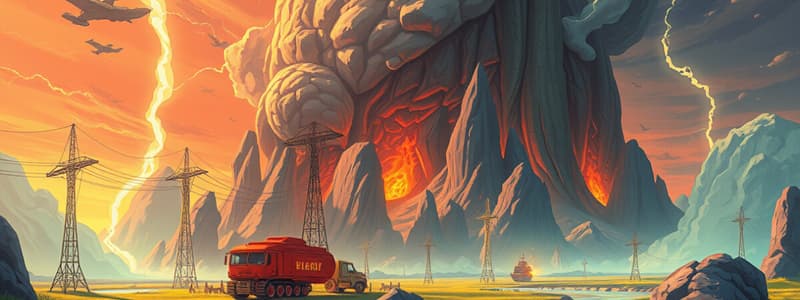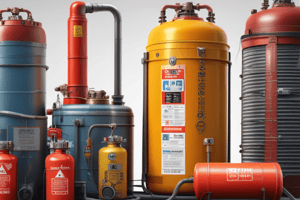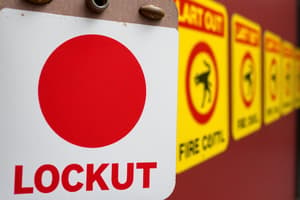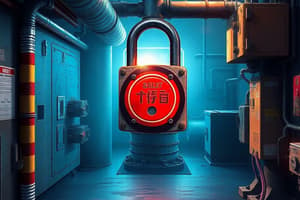Podcast
Questions and Answers
Which of the following statements accurately defines hazardous energy?
Which of the following statements accurately defines hazardous energy?
- Hazardous energy is solely connected to thermal and nuclear energy sources.
- Hazardous energy includes the unintended release of stored energy that could cause harm. (correct)
- Hazardous energy is only related to electrical sources.
- Hazardous energy refers to energy that is predictably managed and poses no risk.
What characterizes stable hazardous energy?
What characterizes stable hazardous energy?
- Energy that is not likely to change. (correct)
- Energy that requires immediate attention.
- Energy that needs regular monitoring.
- Energy that could cause catastrophic failure if left unattended.
In managing hazardous energy, what must take place after identifying and categorizing the energy source?
In managing hazardous energy, what must take place after identifying and categorizing the energy source?
- Appropriate control measures or zoning communications need to occur. (correct)
- The energy source should be completely shut down.
- All personnel must evacuate the area immediately.
- Risk assessment must be submitted to the local government.
How can electrical hazards primarily affect firefighters?
How can electrical hazards primarily affect firefighters?
What is a significant risk associated with downed power lines during firefighting operations?
What is a significant risk associated with downed power lines during firefighting operations?
What should firefighters understand to effectively handle electrical system disturbances?
What should firefighters understand to effectively handle electrical system disturbances?
What can smoke become in terms of electrical hazards?
What can smoke become in terms of electrical hazards?
Which of the following forms of energy is NOT identified as hazardous energy by the NFPA?
Which of the following forms of energy is NOT identified as hazardous energy by the NFPA?
What is a potential indicator of electrical problems, specifically regarding shock potential?
What is a potential indicator of electrical problems, specifically regarding shock potential?
Which action is NOT recommended when encountering downed power lines?
Which action is NOT recommended when encountering downed power lines?
In the event of a transformer fire, what is the recommended approach for firefighters?
In the event of a transformer fire, what is the recommended approach for firefighters?
Which of the following is a hazard associated with wind turbine power generators?
Which of the following is a hazard associated with wind turbine power generators?
What is the composition of Romex wiring?
What is the composition of Romex wiring?
What must be done to prevent BLEVE at LPG and LNG storage vessels?
What must be done to prevent BLEVE at LPG and LNG storage vessels?
Which characteristic is common to both propane and natural gas in their natural state?
Which characteristic is common to both propane and natural gas in their natural state?
What type of surge does the electromagnetic turbine generate during operation?
What type of surge does the electromagnetic turbine generate during operation?
What additional load may photovoltaic solar systems impose on a roof?
What additional load may photovoltaic solar systems impose on a roof?
Which safety measure is crucial when working around UPS battery rooms?
Which safety measure is crucial when working around UPS battery rooms?
What indicates that a high-tension wire may have come loose and poses danger during an incident?
What indicates that a high-tension wire may have come loose and poses danger during an incident?
What is NOT a hazard associated with solar thermal systems?
What is NOT a hazard associated with solar thermal systems?
What is a common misconception regarding energized power lines and solid-stream water applications?
What is a common misconception regarding energized power lines and solid-stream water applications?
What can be a consequence of a damaged sewer or storm drain system?
What can be a consequence of a damaged sewer or storm drain system?
Which of the following is NOT a factor that can contribute to hazardous energy in vehicle incidents?
Which of the following is NOT a factor that can contribute to hazardous energy in vehicle incidents?
How can firefighting efforts introduce hazards within a structure?
How can firefighting efforts introduce hazards within a structure?
Why might closed containers become pressure vessels when exposed to fire?
Why might closed containers become pressure vessels when exposed to fire?
Which characteristic of humidity can negatively affect firefighter operations?
Which characteristic of humidity can negatively affect firefighter operations?
What is a key consideration for ISOs when evaluating wind during firefighting operations?
What is a key consideration for ISOs when evaluating wind during firefighting operations?
What is a danger associated with the failure of air brake chambers in tractors or trailers during a fire?
What is a danger associated with the failure of air brake chambers in tractors or trailers during a fire?
In high-temperature and high-humidity environments, what phenomenon can exacerbate dehydration in firefighters?
In high-temperature and high-humidity environments, what phenomenon can exacerbate dehydration in firefighters?
What factor can affect the collapse of weakened trusses during extreme conditions?
What factor can affect the collapse of weakened trusses during extreme conditions?
Which of the following statements about mechanical systems is incorrect?
Which of the following statements about mechanical systems is incorrect?
What is a potential hazard related to the use of alternative fuel systems in vehicles?
What is a potential hazard related to the use of alternative fuel systems in vehicles?
What should an ISO be concerned about regarding firefighters working outside their temperature norms?
What should an ISO be concerned about regarding firefighters working outside their temperature norms?
What type of disaster can be predicted through preplanning and training for flash floods?
What type of disaster can be predicted through preplanning and training for flash floods?
What is the primary action taken when dealing with hazardous energy sources?
What is the primary action taken when dealing with hazardous energy sources?
Which of the following zones is considered immediately dangerous to life and health (IDLH)?
Which of the following zones is considered immediately dangerous to life and health (IDLH)?
What does lock-out/tag-out (LOTO) safeguards aim to prevent?
What does lock-out/tag-out (LOTO) safeguards aim to prevent?
Which of the following animals poses a significant hazardous energy risk when spooked?
Which of the following animals poses a significant hazardous energy risk when spooked?
What is indicated by the red and white diagonal-striped tape according to the suggested color scheme for control zones?
What is indicated by the red and white diagonal-striped tape according to the suggested color scheme for control zones?
How is the stability of a hazardous energy source categorized?
How is the stability of a hazardous energy source categorized?
In which scenario should urgent communication be initiated?
In which scenario should urgent communication be initiated?
What might be a consequence of inadequate protective cooling in a hazardous energy system?
What might be a consequence of inadequate protective cooling in a hazardous energy system?
What should be added to the estimated collapse height for safety planning?
What should be added to the estimated collapse height for safety planning?
Which type of energy is not classified as hazardous energy?
Which type of energy is not classified as hazardous energy?
What form of communication is discouraged immediately following a hazardous energy incident?
What form of communication is discouraged immediately following a hazardous energy incident?
Which signaling method is NOT suitable for drawing attention to hazardous energy threats?
Which signaling method is NOT suitable for drawing attention to hazardous energy threats?
What equipment in medical care facilities poses a significant hazardous energy risk?
What equipment in medical care facilities poses a significant hazardous energy risk?
What directional factor might affect the size of control zones around hazardous energy sources?
What directional factor might affect the size of control zones around hazardous energy sources?
What is the minimum required clearance from power lines when using conductive equipment?
What is the minimum required clearance from power lines when using conductive equipment?
What is step potential in the context of electrical hazards?
What is step potential in the context of electrical hazards?
Which method is primary for reducing electrical shock threats?
Which method is primary for reducing electrical shock threats?
What hazard is primarily associated with propane and natural gas storage vessels?
What hazard is primarily associated with propane and natural gas storage vessels?
What should firefighters do if they encounter damaged domestic water systems during firefighting operations?
What should firefighters do if they encounter damaged domestic water systems during firefighting operations?
Which devices are typically used in pressurized systems to prevent catastrophic failures?
Which devices are typically used in pressurized systems to prevent catastrophic failures?
What is a significant weather factor that influences fire behavior according to recent studies?
What is a significant weather factor that influences fire behavior according to recent studies?
In what situation should firefighters treat a vehicle with failed air bags?
In what situation should firefighters treat a vehicle with failed air bags?
What should responders do to define control zones around hazardous areas?
What should responders do to define control zones around hazardous areas?
What should be done if temperatures in a pressurized system exceed design limits?
What should be done if temperatures in a pressurized system exceed design limits?
Which alternative energy source generates direct current (DC) using light-collecting materials?
Which alternative energy source generates direct current (DC) using light-collecting materials?
What should a firefighter do when feeling tingling in their feet while on a charged surface?
What should a firefighter do when feeling tingling in their feet while on a charged surface?
What is a critical consideration regarding the evacuation distances for large LPG and CNG storage tanks?
What is a critical consideration regarding the evacuation distances for large LPG and CNG storage tanks?
Which of the following is considered a common mechanical hazardous energy?
Which of the following is considered a common mechanical hazardous energy?
Flashcards are hidden until you start studying
Study Notes
Introduction to Hazardous Energy
- Hazardous energy refers to the unintended release of stored or residual energy that can cause harm upon contact.
- NFPA defines hazardous energy sources as electrical, mechanical, hydraulic, pneumatic, nuclear, thermal, gravitational, and others that may cause injury through unintended motion or release.
Understanding Hazardous Energy Sources
- Energy is categorized by incident safety officers (ISOs) as stable (unlikely to change) or unstable (requires attention).
- Identifying and classifying hazardous energy sources is critical for implementing control measures and communication protocols.
Forms of Hazardous Energy
Electricity
- Proper grounding, insulation, and circuit protection are essential to prevent electrical hazards.
- Firefighters may require local power company assistance; however, they sometimes act independently to mitigate threats.
- General electrical hazards include:
- Electricity seeks the path of least resistance.
- Shock hazards from downed or overhead power lines must be avoided.
- Smoke may become electrically charged.
- Water streams can conduct electricity.
Distribution Grid Components
- Electrical generation and distribution systems, such as substations, can pose hazards during fires.
- Large transformers can hold significant oil quantities, leading to prolonged fires and damage if ignited.
- Wind turbine hazards include rotating blades, heat generation, and potential toxic smoke.
Utility Gas
- Common utility gases like propane and natural gas are colorless and odorless; odorants are added for detection.
- The integrity of gas containment must be evaluated during incidents, especially to prevent BLEVE (boiling liquid expanding vapor explosion).
Water and Flood Hazards
- Waterline breaks can lead to structural instability and sinkhole formation.
- Firefighting efforts can interact dangerously with stored gas pilot lights, leading to hazardous situations.
- Preplanning for flash floods is vital to prevent casualties.
Mechanical Energy
- Mechanical energy is stored in systems like pulleys and cables, which can release suddenly under stress.
- Weakened structures can fail spontaneously, posing risks to responders.
Pressurized Systems
- Hydraulic and pneumatic systems can explode or fail if overheated, especially without proper pressure relief.
- Containers can become explosive under heat, necessitating careful handling during firefighting operations.
Hazardous Energy in Vehicles
- Vehicles present unique hazardous energy risks, including:
- Stability and fuel systems.
- Electrics and HVAC systems that can fail or pose fire risks.
- Airbags that may deploy unexpectedly, injuring rescuers.
Weather
- Wind is the most critical weather factor for firefighting operations, influencing fire behavior and safety.
- Humidity and temperature affect firefighter conditions and fire dynamics.
- Being aware of weather shifts helps ISOs adapt incident strategies accordingly.
Preventive Actions for Hazardous Energy
Awareness and Communication
- Hazard communication is crucial, especially for imminent threats, using urgent priority messages.
- Non-urgent hazards can be communicated through briefings and visual signals.
Avoidance and Zoning
- ISOs must establish control zones based on hazard severity:
- No-entry zone prohibits responders from entering.
- Hot zone is immediately dangerous to life and health.
- Warm zone is safer, allowing operational activities.
- Cold zone serves for command and support activities.
Lock-Out/Tag-Out (LOTO)
- LOTO procedures ensure control of hazardous energy by locking and tagging equipment to prevent accidental activation.
Protective Cooling
- Applying protective cooling prevents critical system ruptures from external heat; precautions must be taken to avoid introducing new hazards during cooling efforts.
Summary
- Hazardous energy includes various forms such as electrical, mechanical, hydraulic, and climatic, which can harm if improperly managed. Identifying and categorizing these energies is essential for firefighter safety and effective incident management. Understanding the complexities behind these energies allows ISOs to implement appropriate control strategies and prioritize safety protocols.### Electrical Hazards
- Loss of integrity in electrical components necessitates urgent communication of potential danger to responders.
- Electrical systems may appear intact but can still be dangerous, particularly when firefighters use aluminum ladders near power lines.
- A minimum clearance of 10 feet (3 m) is required from power lines; distances may increase to 45 feet (14 m) for high voltage.
- Shock hazards from electricity are critical; ground gradient can energize surfaces, leading to step potential which poses risks to firefighters.
Safety Precautions
- Approach charged surfaces with caution; tingling sensations indicate a shock hazard, requiring a shuffle-foot retreat.
- Primary method to mitigate electrical shock risks is to shut off electricity; treat all wires as energized when shutoff isn't feasible.
- Maintain a 10-foot (3 m) clearance from any conductive material, including pooled water.
Alternative Energy Systems
- Substation transformer fires and wind farm turbine incidents require assistance from local electrical companies.
- Uninterrupted power supply (UPS) systems like battery rooms and auxiliary generators may still operate when grid power is off.
- Solar energy systems vary: Photovoltaic (PV) panels generate direct current (DC), while solar thermal panels heat fluids for exchange.
Gas Hazards
- Common utility gases include propane and natural gas, stored as LPG and CNG, posing flammability risks.
- BLEVE (boiling liquid expanding vapor explosion) can occur when flames reach storage vessels; cooling efforts must avoid extinguishing active flames.
- Evacuation may be necessary if high flow rates to prevent BLEVE are unavailable; distances can exceed a mile from gas storage incidents.
Mechanical and Environmental Hazards
- Damaged water systems can create uncontained flow hazards leading to collapses and hazards for trapped victims.
- Mechanical energy risks include tensioned components and pressurized systems; heat may lead to explosive failures in pressurized structures.
- Vehicle hazards encompass fuel systems, heat sources, restraint systems, and alternative fuel sources with distinct responder training needs.
Weather Factors
- ISOs must monitor weather conditions as wind speeds of 10-20 mph (16-32 kph) can lead to extreme fire behavior.
- Hazardous weather conditions include rapid changes, tornadoes, lightning, and severe precipitation; training on storm recognition is crucial.
Miscellaneous Hazards
- Animal rescue during fires presents challenges; large animal rescues usually require professional expertise.
- Medical facilities contain various hazards such as compressed gases and specialized equipment requiring careful management.
Control Zones
- Establish and mark control zones to ensure responder safety:
- No-entry zone (red/white diagonal tape): off-limits to all.
- Hot zone (solid red tape): IDLH area requiring full PPE and accountability tracking.
- Warm zone (yellow tape): Support area for crews and equipment.
- Cold zone (green tape): Command post and staging area for unused equipment.
Studying That Suits You
Use AI to generate personalized quizzes and flashcards to suit your learning preferences.




